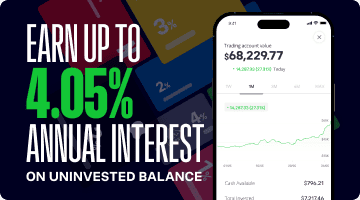Apple shares have lagged behind in 2025, weighed down by sluggish iPhone cycles, soft demand in China, and questions over its AI strategy. But, August delivered some welcome relief, with Apple enjoying its best month in over a year, fuelled by stronger earnings and excitement over the iPhone 17. Now, with a major product launch on the horizon, the stage is set for Apple to prove whether this rebound has real legs. With tariffs still an overhang and big questions around AI, can the iPhone maker regain its shine, or will its rebound lose steam? Let’s find out.
- Apple posted its fastest revenue increase since 2021, with sales up 10% to $94 billion last quarter. That fuelled a 12% stock jump in August, Apple’s best month in over a year.
- The upcoming “Awe Dropping” event will unveil the new iPhone 17 lineup, including a super-slim “iPhone Air” mode plus Apple Watch 11 and AirPods updates. Big tech rivals are sprinting ahead in AI as Apple treads cautiously, leaving investors eager for signs of an AI strategy.
- According to Bloomberg’s Analyst Recommendations, Apple has 33 buy ratings, 22 holds, and 3 sells. The average analyst price target is USD$234.22, signalling a 1% upside from current levels.
Explore Apple
The basics
Apple hardly needs an introduction. It’s the best-known brand in the world, with over 2.3 billion installed devices around the world. Apple’s flagship iPhone remains its backbone, while Mac and iPad remain consumer favourites. Throw in its watches, AirPods and its services division – from App Store to Apple Music – the company’s loyal customer base has made it a cash-generating machine.
But the world’s best can struggle from time to time. Over the past two years, Apple has faced slower iPhone upgrade cycles, a lacklustre Vision Pro debut, and intensifying competition in China. Shares in that time have also only jumped 20%, making it the worst performer amongst its Magnificent Seven peers. After months of sluggish sentiment and share price pain, though, August finally brought relief. Apple delivered its most impressive quarter in years, and shares surged 12%, their best month in more than a year.
Now Apple heads into September with all eyes on its “Awe Dropping” event, where it will unveil the new iPhone 17 lineup. The company is also expected to announce Apple Watch Series 11 and new AirPods Pro, and possibly tease a future foldable iPhone as it lays the groundwork for its biggest product shake-up in over a decade. More on-device AI features are anticipated, too, as Apple looks to catch up on AI integration in its devices, especially as Apple has visibly lagged big-tech rivals in rolling out tangible AI products. Its big tech rivals are sprinting ahead in AI, while Apple is barely out of the blocks, all reflected in share price performance in the last two months.
So the question is whether this recent rebound and the looming product launch can reignite lasting momentum. The next few weeks will test whether Apple can wow the market or if its recent lull will continue.
Fun Fact: Apple’s AirPods sales generate around USD$20 billion each year, which is more than companies such as Spotify, Hermès, Qantas, and Hilton Hotels make in revenue every year.

Competitor Diagnosis
Apple may be a titan, but it’s not invincible, especially in the almost half a trillion smartphone market. But it still holds the crown as the best-selling smartphone manufacturer in the world. Samsung is Apple’s biggest rival, right on Apple’s tail for global smartphone volumes, with a strong breadth of different models. Samsung has also led in foldable phones. Its Galaxy Z Fold and Flip devices are now several generations in, defining a category where Apple has yet to participate.
Another tech giant, Google, is in the mix. Its Pixel smartphones hold only a small single-digit market share, but they showcase cutting-edge software integrations. However, its Android ecosystem is the crown jewel, dominating with 72% of global mobile OS share vs. 27% for Apple iOS.
In China, local tech giant Huawei has staged a major comeback. After years of sanctions, Huawei reclaimed the top spot in the Chinese smartphone market in Q2 2025, grabbing about an 18% share. Apple did, though, see growth in China last quarter, the first time in two years, but this was largely thanks to steep promotions and subsidies on the iPhone 16.
Beyond smartphones, Apple battles across wearables, earbuds, and services, but the iPhone remains its profit engine. The strength of its ecosystem, from iCloud to Apple Music, keeps users tied in, making upgrades almost inevitable.
Despite a strong month, hurdles are still ahead for Apple. Huawei’s resurgence in China, price pressures in emerging markets, and rivals racing ahead in foldables and AI. Apple is countering by leaning on its integration, privacy, and premium brand. Let’s also not forget tariffs, estimates have around 80% of Apple’s products made in China, a huge risk for Apple’s bottom line. They’re moving fast to react by reducing China’s reliance through Indian iPhone production and a $100 billion U.S. manufacturing push. These moves aim to safeguard its moat as competition intensifies.

Financial Health Check
Apple’s latest earnings were a bright spot in an otherwise lacklustre year. After multiple quarters of tepid growth, Apple’s fiscal Q3 2025 results blew past expectations and offered a glimmer of optimism for investors.
Revenue climbed 10% to USD$94 billion, with product sales rising 8% and iPhone revenue up 13% year-on-year, helped by strong demand for the iPhone 16e and a pre-tariff buying rush from US consumers. Apple shipped its 3 billionth iPhone and noted a record June quarter for upgraders. Services revenue was another bright spot, up 13%, showing resilience despite mounting regulatory pressure. Guidance for next quarter was also solid, suggesting momentum could continue, especially with the iPhone 17 on the horizon.
Not everything was rosy. iPad and Wearables sales fell, with Vision Pro underwhelming. Meanwhile, a USD$1.1 billion tariff bill looms in the current quarter, which could weigh on margins and test Apple’s pricing power again.
AI remains the big question mark. Despite its financial strength, Apple is notably behind its peers in showcasing a clear AI strategy. Management’s commentary acknowledged this gap; Tim Cook stated that Apple will “significantly” increase its investments in artificial intelligence and is open to acquisitions that accelerate its roadmap.
Apple’s management also sounded an optimistic note for the coming quarter. While Apple doesn’t give formal forecasts, it suggested momentum could continue into the fall, especially with the iPhone 17 launch on deck. CEO Tim Cook highlighted that customer satisfaction and loyalty are at all-time highs, fueling a growing installed base. The company also announced a USD$0.26 dividend and continued the biggest share buyback in the world, repurchasing around USD$110 billion of its own stock in the past year alone. No surprise given Apple’s enormous cash generation with free cash flow at over USD$100 billion for this fiscal year. These capital returns are a key part of Apple’s appeal, ensuring shareholders benefit even in slower growth years.
Buy, Hold or Sell?
Apple is a fortress business, a cash-generating machine with unrivalled brand loyalty, huge margins, and an ecosystem that locks in users, leading to repeat purchases and service revenue. Its balance sheet is rock-solid, and shareholder returns through buybacks and dividends remain constant. These qualities make Apple a long-term stalwart that many investors justifiably hold through thick and thin.
However, shares are trading at around 30x forward earnings, above the S&P500’s multiple of 23x and well above their own 10-year average of 20x. This means that after a solid rally in August, the risk-reward is finely balanced. Analysts’ price targets also aren’t a screaming buy on the stock. Apple’s recent run has restored a lot of confidence, but it’s also restored a premium price.
According to Bloomberg’s Analyst Recommendations, Apple has 33 buy ratings, 22 holds, and 3 sells. The average analyst price target is USD$234.22, signalling a 1% upside from current levels.

The investor takeaway?
Investors also know not to get too carried away. History shows Apple’s stock often rallies before iPhone launch events, then cools off once the new gadgets are revealed. However, this time the macro backdrop could provide a tailwind: an expected Fed interest rate cut is on the horizon, which would ease pressure on consumers’ wallets. If the iPhone 17 lineup impresses, a strong upgrade cycle could be on the cards, especially with many users due for an upgrade. Here are 5 things to watch closely:
iPhone 17 cycle: The big near-term catalyst.
Services and ecosystem: High-margin Services growth remains vital.
Competition and market share: Huawei’s resurgence in China and tougher emerging market pricing threaten Apple’s dominance.
Macro tailwinds: Expected Fed rate cuts could boost consumer spending, supporting upgrades.
AI and new categories: Investors want signs that Apple won’t miss the AI wave.
Apple has proven time and again that it can weather storms and come out stronger, with its recent earnings suggest it still has plenty of life left. The company’s near-term prospects hinge on executing the iPhone 17 launch and convincing the market it has an AI plan. If it succeeds, today’s valuation will look justified.
Explore Apple
eToro Service ARSN 637 489 466 promoted by eToro AUS Capital Limited ACN 612 791 803 AFSL 491139. Capital at risk. See PDS and TMD. This communication is general information and education purposes only and should not be taken as financial product advice, a personal recommendation, or an offer of, or solicitation to buy or sell, any financial product. It has been prepared without taking your objectives, financial situation or needs into account. Any references to past performance and future indications are not, and should not be taken as, a reliable indicator of future results. eToro makes no representation and assumes no liability as to the accuracy or completeness of the content of this publication.






